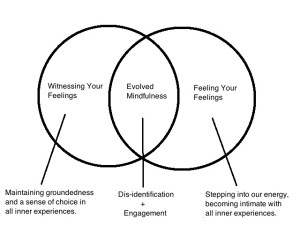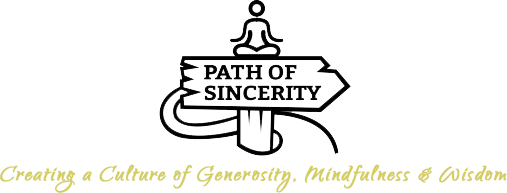After doing so much meditation, I came to a place where I was highly proficient at “witnessing” my inner reality. I could recognize even the subtlest emotions the moment they began—I knew how they felt energetically in the body, their associated thoughts and, often, the underlying reasons they arose.
Seeing all that in real-time was a tremendous way to demystify the ego. I didn’t really get phased by much. Good or bad. I was solidly in the middle. I lived my life in a place of enormous spaciousness.
And yet, something seemed a little off.
I spoke with a teacher who pointed out that while my strong awareness was definitely the right path, she saw in my eyes a hint of weariness, and suggested maybe I wasn’t channeling it the right way. She gazed at me longingly and said there are two basic directions for awareness:
The first, dis-identification, she said is a high spiritual quality full of centeredness and aliveness. A dis-identified person welcomes whatever experiences or emotions come, but also has enough inner strength to not get entangled or carried away. No matter what’s happening, they remain rooted in their deeper identity and their innate human desire to love and serve.
The second, dis-engagement, she said is a form of aversion that, while spacious and grounded, is devoid of life-force. A dis-engaged person doesn’t want to deal with certain things, and their inner strength can be used to avoid, even subconsciously, truly experiencing certain places inside themselves. It leaves a person feeling like something is a little off.
The bridge, she told me, was to palpably feel my feelings.
………..

………
For many people, the major challenge is developing the witness. As such, most the mindfulness instruction you’ll find is pointing you developing basic focus, concentration and awareness skills.
Just try being aware of, say, your breath for 10 consecutive minutes. Tricky, isn’t it? However, it’s like any other skill—the more you do it, the more proficient you become. And, as your awareness of obvious things develops, so does your awareness of your mental-emotional states. This is when the sense of spaciousness, inner stability and profound choice come into the picture.
However, like what happened to me, it’s entirely possible to be unbalanced with the witness—I realized that I often slipped into those “weary eyes,” where I wasn’t really in my thoughts or my body, I was just in space, dis-engaged from life.
On the other side, another major challenge is to feel our feelings. With or without awareness strength, many of us are habituated to numb-out, suppress, self-distract, dis-associate, think think think, or dis-own our feelings and their energy.
……….
This site is filled with resources to develop the witness, so here I’ll offer some specific strategies to step more into our feelings. I’d suggest skimming this list, picking just one and trying it out for a week or two.
1) Be with the energy in the body. All feelings are embodied. They have an energetic feel that flows through the body. They generally also have thoughts and mind-states attached to them. The more you can stay out of the stories, and the more you can stay with the energy, the more intensely alive you’ll feel. If you have a sitting meditation practice, you could literally just do this.
2) A powerful mindfulness experiment. Sit in formal meditation for 10-15 minutes. For the first few minutes, just relax, do nothing, allow yourself to settle. Then, begin your mindfulness practice with the body-object of your choice: the breathing, the-field-of-body-sensations, a specific body sensation or scanning the body.
For a few minutes, explore this prompt: “observe the body.” Then, switch to this prompt: “feel the body.”
Interesting, right? Most people find that one of those makes them feel much more intimate with their experience (aka their life). Intimacy is the path!
3) Allow every emotion. Of course, something like anger can be very destructive. Likewise, many of us have good reason to disown “negative” emotions—whether that’s memories of judgement, push-back or getting totally lost in that state.
However, there’s life-force in anger, shame, fear and sadness. We can absolutely have those feelings and be totally whole and thriving. A good place to start with this is noticing your own inner critic. Do you judge yourself when you have a “negative” emotion? Do you want to get rid of those feelings? What exactly does that inner voice say?
Basically, have that spirit of welcoming with even the darkest feelings. Notice how to inner critic tries to dis-allow emotion; but, most of all, keep reverting to #1 — be with the energy in the body.
4) Practice expression. If we really feel the energy of our emotions and can let it pass through us, then it isn’t necessarily important to express them. However, as it’s almost impossible to express emotions without feeling them, the act of expressing is itself a fool-proof method of feeling your feelings.
Expression could be journaling or talking to someone (or ourselves). It could also mean letting our tears flow, yelling into a pillow, jumping wildly, dancing, releasing our anger into a set of drums, using our body language, etc.
*An important note is that responsible expression is very important. Cause as little harm as possible while still being real with yourself.
5) Play. We Westerners are are generally way too serious. Seriousness is a “head” mode-of-being—there’s no feeling there. A good way to thrust us into lightness and openness is through play, silliness and non-competitive games.
Building a snowman or sandcastle. Writing a poem. Solo dancing (by yourself to your own tunes, or at something like ecstatic dance or Five Rhythms). Leisurely walks. Play catch or ping pong or billiards or go bowling. Get some chalk and invite a friend over for hopscotch. Play chess or checkers. Draw pictures in coloring books, on canvas or doodling. Mess around with an instrument. Skip down a city block. Look for treasures in the park (like pinecones, neat stones, leaves or bark!).
I would go so far as to say that if 24 hours passes and you’ve experienced no play, then you haven’t actually lived that day. When you do play, notice how porous and connected you are to your feelings.
6) Move from head-to-heart.
Many people a sort of existential confusion or pointlessness. That’s a “head” state. When we tune in deeper, we might find sadness, weariness or exasperation. Those have bodily energy. Stay with that feel.
Consider thoughts of how someone wronged you, how inappropriately they’ve acted, how annoying they are or how they really should figure out how to put the pickle jar away. Those are stories. We cycle through them over and over; however, if we revert to #1, we find raw anger. Subtle, perhaps, but still anger.
Any time there’s rumination on the future, worry, excessive planning or great dreams, there’s always some immediate feeling. Maybe it’s anxiety. Maybe it’s aversion towards your life right now. Maybe it’s excitement. Maybe it’s fear. All of those are feelings. They have body-energy.
If you don’t know what you’re feeling, just tune into the basics: how your relaxed, tired, energized, etc. All of those have a certain feel in the body.
…………
Summary
In a later encounter with that teacher, she noticed my eyes beaming and asked, “how do you feel?” I said, “on fire for life.” From the previous time, it was just a subtle shift, but also a monumental one:
The witness is very, very important—without it, we’re reactive and often overpowered by the intensity of life. It’s what keeps inner stability and the sense that everything is always okay. However, another part of our innermost core is our basic moment-to-moment feelings.
Evolved mindfulness doesn’t come through transcending or getting rid of those feelings; it comes when the strength of the witness is alongside an engagement of our feelings, honoring them, and channeling them skillfully.
The more evolved my mindfulness has become, the more I can truly appreciate life.

I feel and think this is the very best article I have read. Regardless my stage of awareness, I often witness that judge in me attempting to intellectualize my state awareness, as if I can find a way to think it through. Some of that comes from my working history of attempting to recognize my own defence mechanisms in the presence of witnessing those arising in the one I was working with. We not only deserve to feel our feelings, healing even if seems to fade and arise again, is made possible. I’m grateful I managed to stumble into this article. Thank you.
This article really resonates for me. Thank you!